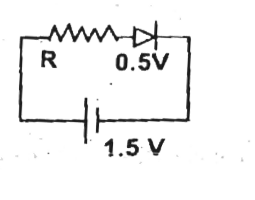A light emitting diode has a voltage drop of across it and passes a current of . When it operates with a battery through a limiting resistor . The value of is
The correct Answer is:D
To solve the problem, we need to determine the value of the limiting resistor R when a light emitting diode (LED) operates with a 6V battery. The LED has a voltage drop of 2V and passes a current of 10mA.
1. Identify the given values:
- Voltage drop across the LED, VLED=2V
- Current through the LED, I=10mA=10×10−3A=0.01A
- Voltage of the battery, Vbattery=6V
2. Calculate the voltage across the resistor R:
- The voltage across the resistor can be found using the formula:
VR=Vbattery−VLED
- Substituting the values:
VR=6V−2V=4V
3. Use Ohm's Law to find the resistance R:
- Ohm's Law states that:
V=I⋅R
- Rearranging this gives:
R=VRI
- Substituting the values we have:
R=4V0.01A
4. Calculate the resistance:
- Performing the calculation:
R=40.01=400Ω
5. Conclusion:
- The value of the limiting resistor R is 400Ω.
Final Answer:
The value of R is 400Ω.
---
- Voltage drop across the LED, VLED=2V
- Current through the LED, I=10mA=10×10−3A=0.01A
- Voltage of the battery, Vbattery=6V
- The voltage across the resistor can be found using the formula:
VR=Vbattery−VLED
- Substituting the values:
VR=6V−2V=4V
- Ohm's Law states that:
V=I⋅R
- Rearranging this gives:
R=VRI
- Substituting the values we have:
R=4V0.01A
- Performing the calculation:
R=40.01=400Ω
- The value of the limiting resistor R is 400Ω.
The value of R is 400Ω.
Similar Questions
A light-emitting diode (LED) has a voltage drop of 2V across it and passes a current of 10μA, when it operates with a 6V battery with a limiting resistor R. what is the value of R ?
View SolutionA P−N junction diode can withstand currents up to 10mA. Under forward bias, The diode has a potential drop of 0.5V across it which is assumed to be independent of current. The maximum voltage of the battery used to forward bias the diode when a resistance of 200Ω is connected in series with it is
View Solution
Knowledge Check
An n-p-n transistor in a common-emitter mode is used as a simple voltage-amplifier with a collector current of 4 mA. The terminals of a 8 V battery is connected to the collector through a load-resistance RL and to the base through a resistance RB. The collector-emitter voltage VCE=4V, the base-emitter voltage VBE=0.6V and the current amplification factor βdc=100. Then
ARL=1kΩ,RB=185kΩBRL=2kΩ=RBCRL=2kΩ,RB=15kΩDRL=185kΩ,RB=1kΩ
An n-p-n transistor in a common - emitter mode is used as a simple voltage amplifier with a collector current of 4 mA. The positive terminal of a 8 V battery is connected to the collector through a load resistance RL and to the base through a resistance RB . The collector - emitter voltage VCE=4V , the base - emitter voltage VBE=0.6V and the current amplification factor β=100 . Calculate the values of RL and RB .
View SolutionThe diode used in the circuit shown in the figure has a constant voltage drop of 1V at all current and a maximum power rating of 100mW. What should be the value of the resistor R, connected in series with the diode for obtaining maximum current put less l?

View SolutionWhen a diode is forward biased, it has a voltage drop of 0.5 V. The safe limit of current through the diode is 10 mA. If a battery of emf 1.5 V is used in the circuit, the value of minimum resistance to be connected in series with the diode so that the current does not exceed the safe limit is :
View SolutionIn the circuit shown in fig the voltage across the 6Ω resistor is 12V. What is the emf of the battery and the current thorugh the 6Oemga resistor?

View SolutionA Zener diode with a breakdown voltage of 4 V is connceted in sereis with a resistance R to a battery of emf 10 V. The maximum power dissipation rating for the Zener diode is 1 W. The value of R to ensure maximum power dissipation across the diode is
View SolutionWhen a voltage V=V0 cos ωt is applied across a resistor of resistance R, the average power dissipated per cycle in the resistor is given by
View SolutionThe diode used in the circuit shown in the adjacent figure has a constant voltage drop of 0.5V at all currents and a maximum power rating of 100mW.What should be the value of resistor R connected in series with the diode for obtaining maximum current?

View Solution
